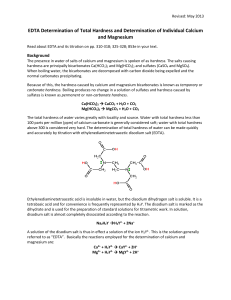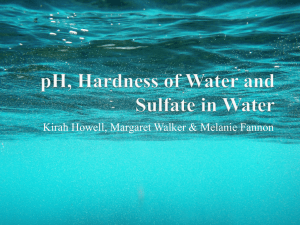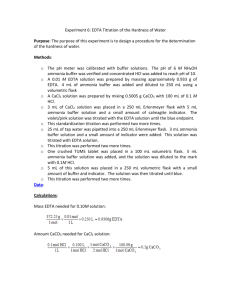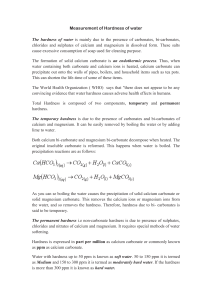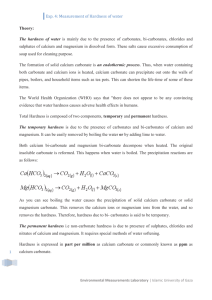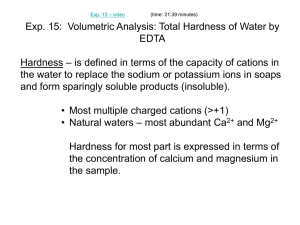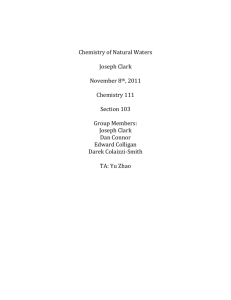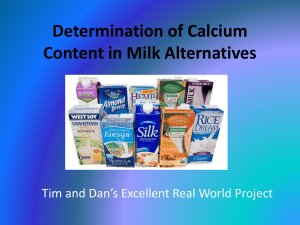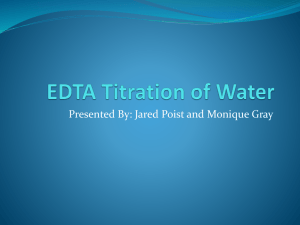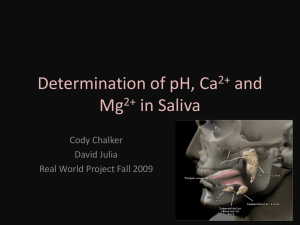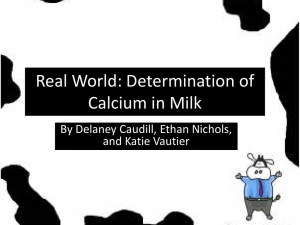calcium and magnesium content by titration
advertisement
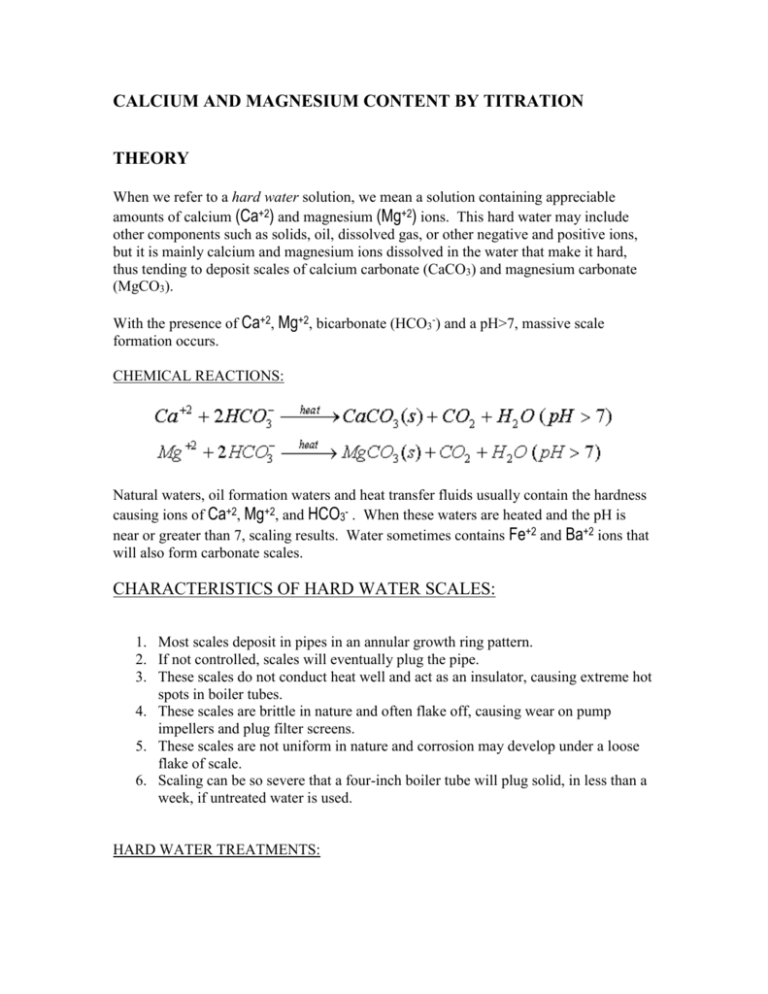
CALCIUM AND MAGNESIUM CONTENT BY TITRATION THEORY When we refer to a hard water solution, we mean a solution containing appreciable amounts of calcium (Ca+2) and magnesium (Mg+2) ions. This hard water may include other components such as solids, oil, dissolved gas, or other negative and positive ions, but it is mainly calcium and magnesium ions dissolved in the water that make it hard, thus tending to deposit scales of calcium carbonate (CaCO3) and magnesium carbonate (MgCO3). With the presence of Ca+2, Mg+2, bicarbonate (HCO3-) and a pH>7, massive scale formation occurs. CHEMICAL REACTIONS: Natural waters, oil formation waters and heat transfer fluids usually contain the hardness causing ions of Ca+2, Mg+2, and HCO3- . When these waters are heated and the pH is near or greater than 7, scaling results. Water sometimes contains Fe+2 and Ba+2 ions that will also form carbonate scales. CHARACTERISTICS OF HARD WATER SCALES: 1. Most scales deposit in pipes in an annular growth ring pattern. 2. If not controlled, scales will eventually plug the pipe. 3. These scales do not conduct heat well and act as an insulator, causing extreme hot spots in boiler tubes. 4. These scales are brittle in nature and often flake off, causing wear on pump impellers and plug filter screens. 5. These scales are not uniform in nature and corrosion may develop under a loose flake of scale. 6. Scaling can be so severe that a four-inch boiler tube will plug solid, in less than a week, if untreated water is used. HARD WATER TREATMENTS: Hard water can be softened by many techniques we will be studying. Water treatment can lower the concentration of hard ions to an acceptable level. Ion exchange can substitute softer sodium ions for the hard ions, making the water soft but also corrosive. Once an acceptable level of hardness has been achieved, scale formation can be controlled by various additives HARD WATER SCALE REMOVAL: Once scales are formed they can be removed slowly by changing the water chemistry and actually dissolving the formed scale. Scales can be mechanically removed by reaming, a type of mechanical machining inside the pipes. Scales can also be removed by acidizing with strong mineral acids, such as HCl, containing inhibitors that will prevent the pipes from being dissolved. If the scale contains FeS, ferrous sulphide, which is a black colored band of precipitate, then extreme care has to be followed since deadly H2S, hydrogen sulphide, gas is liberated on acidizing. METHOD OVERVIEW: To determine the hardness of a water sample, technologists use the EDTA (ethylenediaminetetraacetic acid) titration. EDTA disodium salt is a soluble salt that reacts readily with all +2 ions, namely Ca+2, Mg+2, Fe+2 and Ba+2. The EDTA anion reacts quickly with any +2 metal to form a soluble metal EDTA complex. EDTA is called a chelating or sequestering agent since it will react with and tie up heavy metal ions and render them harmless to humans and water systems. All metal-EDTA salts are colourless and require an indicator to tell us when the reaction is over. Various hardness indicators have been developed. They all tell the operator when the titration is complete. Hardness indicators are large complex organic dyes that react with EDTA to form coloured complexes. EDTA reacts preferentially with highly mobile metal ions, but once they are all tied up, the EDTA will react with the slow moving, massive dye molecules to give an endpoint. As a consequence, endpoints are challenging. We will use Eriochrome Black T for the total hardness endpoint, which includes the sum of calcium and magnesium ions. Murexide indicator gives us the calcium endpoint. TOTAL HARDNESS REACTION: CALCIUM REACTION: THE VOLUME DIFFERENCE OF EDTA TITRATED BETWEEN THE TOTAL HARDNESS ANALYSIS AND THE CALCIUM ANALYSIS IS THE MAGNESIUM RESULT. Total hardness - calcium hardness = magnesium hardness MATHEMATICAL RELATIONSHIPS: Molarity of EDTA solution is 0.01 M mL of 0.01 M EDTA = 1 mg of CaCO3 EDTA molarity x EDTA volume (L) = Ca+2 molarity x Ca+2 volume (L) or, using volumes PROCEDURE CALCIUM HARDNESS DETERMINATION 1. Fill a 50 mL burette with 0.01 M EDTA solution, making sure the tip is full and free of air bubbles. Set Start volume. 2. Add 50.00 mL of an unknown hard water solution into a 100 mL beaker. 3. Obtain Magnetic Stirrer from Equipment menu. Place beaker on stirrer. Increase Stir from the context menu. 4. Add 4 mL of 1.0 M Sodium Hydroxide. 5. Add 100 mg of Murexide indicator. 6. Titrate with the 0.01 M EDTA until the colour changes from salmon pink to orchid purple. Record all pertinent data on data sheet. Read burette to +/- 0.10 mL. 7. Repeat the titration until the final volumes agree to +/- 0.20 mL. TOTAL HARDNESS DETERMINATION 1. Fill a 50 mL burette with O.1 M EDTA solution, making sure the tip is full and free of air bubbles. Set Start volume. 2. Add 50.00 mL of an unknown hard water solution into a 100 mL beaker. 3. Obtain Magnetic Stirrer from Equipment menu. Place beaker on stirrer. Increase Stir from the context menu. 4. Add 10 mL of Ammonia to the beaker. 5. Add 100 mg of Eriochrome Black T indicator. 4. Titrate with the 0.01 M EDTA until the colour changes from wine red to pure blue. Record all pertinent data on data sheet. Read burette to +/- 0.10 mL. 6. Repeat the titration until the final volumes agree to +/- 0.20 mL. Incidentally, EDTA is a common food additive that is used in salad dressing and other spicy condiments. It is totally safe for sink disposal. BE CAREFUL WITH CALCIUM AND TOTAL HARDNESS BUFFERS Spills on your skin or the floor are corrosive and should be washed off with soap and water immediately. Be sure to wear your safety glasses at all times as permanent blindness can easily result from strong bases splashed into your eyes. DO NOT wear contact lenses. Ask your instructor for further information. REPORT 1. PLEASE SHOW DETAILED CALCULATIONS FOR THE FOLLOWING: Molarity of calcium in unknown: ppm calcium in unknown: ppm calcium carbonate in unknown: Volume of EDTA for magnesium portion: ppm magnesium in unknown Questions 1. A corrosion technologist pipetted a 100.00 mL hard water sample and titrated it with 37.64 mL of 0.01 M EDTA solution for a total hardness endpoint, and 29.32 mL of 0.01 M EDTA solution for a calcium endpoint. Calculate the concentration of magnesium and calcium in ppm. Record your answers as ppm Mg2+, and Ca2+ espectively. For each answer indicate the ppm as CaCO3 also. 2. and Write and balance the reaction between the magnesium ion, the bicarbonate ion heat. 3. Write and balance the scale removal reaction involving the scale generated in question #2 with HCl. 4. In a sour water system (H2S) there is an opportunity for ferrous sulphide to form along with the calcium and magnesium carbonate scales. If acidizing is used to clean away scales, what danger exists? Indicate this by using a balanced reaction. 5. In the field, where the scale in question #4 is removed by acidizing, what precautions should be taken? NAME: ____________________________ SECTION: _________________________ ______________________________ DATE: CALCIUM CONTENT OF A HARD WATER UNKNOWN INFORMATION FROM LABEL: ___________________________________ CONCENTRATION OF STANDARDIZED EDTA SOLUTION:____________________ Trial #1 Trial #2 Trial #3 Sample volume Final burette reading Initial burette reading Volume titrated AVERAGE OF 2 BEST TITRATION’S: ___________________________________ CALCIUM AND MAGNESIUM CONTENT OF A HARD WATER Trial #1 Trial #2 Trial #3 Sample volume Final burette reading Initial burette reading Volume titrated AVERAGE OF 2 BEST TITRATION’S: ___________________________________
